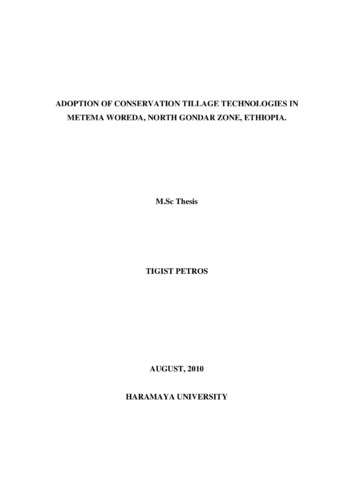Adoption of conservation tillage technologies in Metema Woreda, North Gondar Zone, Ethiopia
Abstract
As in most parts of Ethiopia, soil degradation has posed a serious challenge to the productivity of agriculture in the high rainfall areas of Metema Woreda of the Amhara Regional State. Crop productivity in the Metema area is further constrained by weeds which are favored by the high rainfall and temperature characterizing the area. Current weed control practices involving repeated plowings (often up to four times) and hand pulling imposes not only high production costs but also aggravated soil degradation affecting the sustainability of agricultural production. In an attempt to improve agricultural productivity and reduce soil degradation, conservation tillage (CT) technology involving zero tillage with or without pre-emergence herbicide was introduced in Metema woreda since 2005. This study, therefore, explored the CT adoption decision behavior of smallholder farmers in the Metema woreda of the Amhara Regional State. A multistage sampling procedure was used to identify peasant associations and then households. In the first stage, the PAs were stratified into two groups based on the degree of conservation tillage extension efforts. The selected PAs were further stratified into two based on distance to the woreda capital. Then, two PAs form early exposed and two PAs from the late exposed groups were selected. Finally, a total of 130 household heads were selected randomly using probability proportional to size from the identified PAs. Both qualitative and quantitative data were collected from the sampled households. While the qualitative data were generated from focus group discussions and key informants using check lists, quantitative data were collected from sampled households using structured interview schedule. The structured interview schedule was pre-tested, revised and then administered by well-trained enumerators recruited from the study area. Descriptive statistics such as mean, standard deviations and frequencies were used to summarize the data while binary logit model were fitted to identify the most important variables influencing CT adoption decision behavior of sample households. Study results revealed that 54.1% of sample farmers adopted CT during the study year. Friends, neighbors and development agents were found to be the major sources of knowledge suggesting farmer to farmer communication plays a crucial role in knowledge transfer in the study area. Results of the econometric (binary logit) model indicated that farming experience of household heads, land holding, social participation, frequency of contact with extension agent, and frequency of participation in field days were found to have positive and significant influence on adoption of conservation tillage technology further signifying the importance of appropriate communication strategies in technology adoption. Generally, the result of this study indicates that adoption of conservation tillage technology is a result of an interplay of several factors, which should be given due attention in the generation and transfer of agricultural technologies including conservation tillage.

